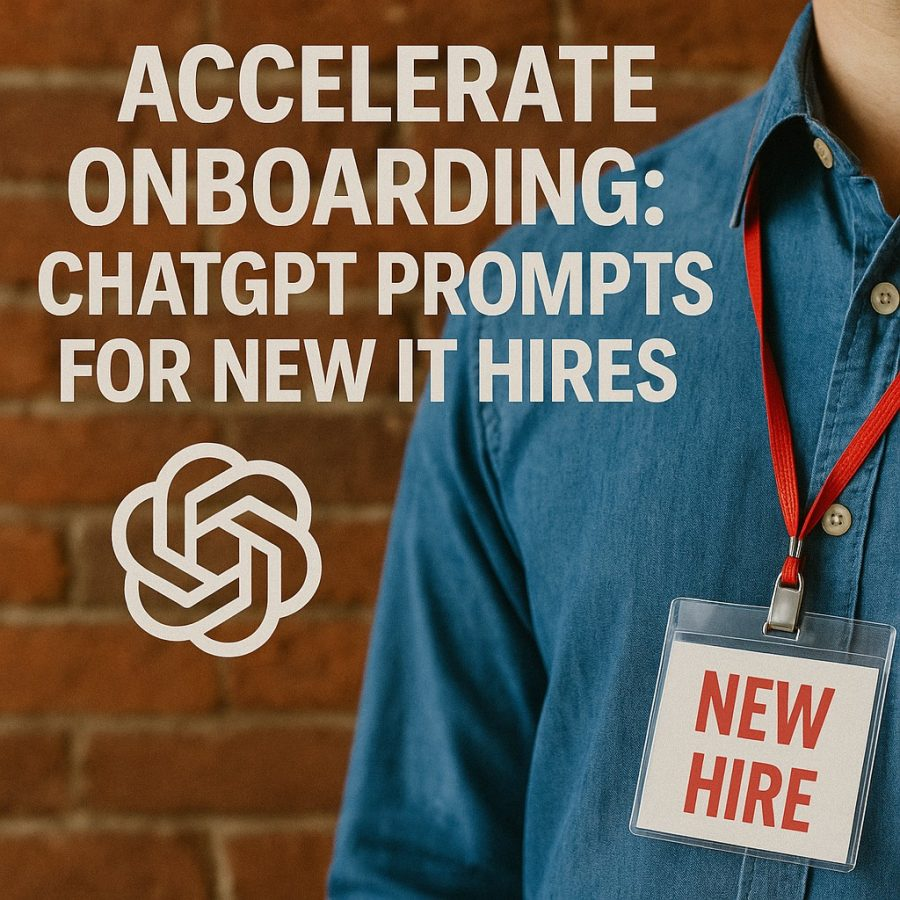Views: 2
Onboarding new IT hires is more than handing over access credentials and expecting them to sink or swim. A fast, smooth onboarding process shapes how someone sees their role, impacts productivity, and influences retention. When you use ChatGPT Prompts for New IT Hires thoughtfully, you can accelerate ramp-up time, reduce mistakes, and help new staff contribute more quickly.
In this article you will discover what makes effective onboarding for technical roles, how to build prompt templates that support learning and integration, and how to implement workflows that use AI to enhance the onboarding experience. I will also present sample prompts, best practices, and pitfalls to avoid.
What Onboarding Means in the IT Context
When someone joins an IT team they face many challenges: unfamiliar systems, complex architectures, internal tools, versioning, deployment pipelines, documentation gaps, security policies, configuration management, and cultural norms. Without structured onboarding someone may waste days or weeks asking basic questions, repeating avoidable errors, or feeling lost.
Studies of onboarding programs show that:
- Preboarding (before Day 1) reduces anxiety and improves early engagement. (AIHR)
- Clear role definitions and expectations during first week reduce confusion. (HR | George Mason University)
- Mentorship or buddy systems help new hires navigate culture, tools, workflow. (Deel)
In an IT setting you must also ensure that systems access, toolchain, environments are ready. If infrastructure is not ready, onboarding stalls immediately.
Affiliate Link
See our Affiliate Disclosure page for more details on what affiliate links do for our website.
Key Principles Behind Accelerated Onboarding for IT Hires
To design prompts that support acceleration, understanding guiding principles helps.
Preparedness
Everything must be ready: hardware, software accounts, access rights, required credentials. New hires should arrive without friction. The tools they need should be configured. One best practice is setting up workstations and access before the first day. (Indeed)
Clarity of Expectation
Define what success looks like in first week, first month, first three months. New hires need to know which systems to learn, which tools to master, what outcomes are expected. Studies show 30-60-90 day plans improve productivity and confidence. (AIHR)
Social and Cultural Integration
Buddy systems, peer mentors, early introductions to team culture, values, workflows matter. Remote or hybrid settings especially benefit from scheduled introductions. (360Learning)
Incremental Learning
Do not overload with all information at once. Spread training and knowledge across days or weeks. Use microlearning modules, paired with hands-on exposure. (360Learning)
Feedback Loops
Frequent check-ins, mentoring, opportunities for new hires to ask questions or highlight gaps are essential. Early issues left unaddressed may become larger. (ADP)
How ChatGPT Can Be Leveraged
ChatGPT (or similar large language models) can assist across many parts of onboarding for new IT hires. Some uses include:
- Generating structured documentation (tool guides, environment setup, deployment SOPs)
- Drafting FAQs for common issues new hires face
- Preparing onboarding schedules, checklists, role responsibilities
- Simulating system architectures or code walkthrough explanations
- Generating quiz or knowledge check questions to test understanding
Using prompts built around these activities accelerates ramp-up and reduces dependency on senior engineers for repetitive onboarding tasks.
Affiliate Link
See our Affiliate Disclosure page for more details on what affiliate links do for our website.
Components of Effective Prompts for New IT Hires
When writing ChatGPT Prompts for New IT Hires, certain components improve output quality. Use these components in your prompt templates.
- Role & Responsibilities
Describe the job title, scope, responsibilities. Which systems they will touch, which tools they must learn. - Environment & Toolchain Details
Include operating systems, version control tool (Git, etc.), CI/CD tools, cloud or on-premise, programming languages, frameworks. - Learning Objectives / Goals
What should the new hire be able to do after X days: clone repos, deploy to staging, debug issues, write tests. - Structure: timeline or phases
Should the prompt output a 30-60-90 day plan or weekly breakdown? Defining phases helps manage expectations. - Format: checklist, guide, schedule, tutorial
Specify whether the output should be checklist, step by step guide, schedule template, comparison table. - Examples and References
If existing internal docs exist, or if you have prior examples of good onboarding, include or reference them so ChatGPT can match style. - Context About Culture & Policies
Security practices, coding standards, naming conventions, merge request workflows. These are part of what new hires must absorb. - Assessment or Feedback Plan
Include in prompt suggestions for quizzes, knowledge checks, mentor check-ins.
Sample Prompt Templates
Below are templates you can adapt. They use ChatGPT Prompts for New IT Hires as theme, so you can copy and modify for your organization.
Template 1: 30-60-90 Day Onboarding Plan
You are an onboarding planner. I will give you the role title, tools the new hire must use (e.g. Git, Docker, Jenkins, AWS), team structure, and key deliverables. Create a 30-60-90 day plan with weekly milestones. Include skills to learn, systems to become familiar with, code contributions goals, communication check-ins with mentor. Format as a table: Week, Objectives, Tools, Expected Outcome.
Template 2: Environment Setup Guide
You are a documentation assistant. The new IT hire will work in a Linux environment, needs access to version control, containerization, deployment pipeline, logging, monitoring tools. Generate an environment setup guide: steps to install or configure each tool, where to find credentials, sample configurations, verification checks.
Template 3: Common Issues FAQ
You are a support assistant. Prepare an FAQ for new hires containing common problems when starting: permissions errors, build failures, missing dependencies, environment mismatches, network access issues. For each problem give symptom description, likely cause, diagnostic steps, solution, and prevention advice.
Template 4: Codebase Tour
You are a developer mentor. I will provide a codebase summary: modules, architecture layers, key services. Create a guided codebase tour for a new hire: component explanation, directory structure, where tests live, how to run locally, main config files, how to deploy. Include diagrams or file tree examples.
Template 5: Role Responsibilities and Expectations
You are role clarity assistant. Given role name, team goals, systems touched, expected deliverables, and communication channels, draft a document outlining role responsibilities, metrics, reporting relationships, collaboration norms, expected first-month evaluation criteria.
Affiliate Link
See our Affiliate Disclosure page for more details on what affiliate links do for our website.

Amazon Fire TV 50″ 4-Series 4K UHD smart TV, stream live TV without cable, 2024 release
Best Practices for Implementing These Prompts
Here are practices to maximize impact when using ChatGPT Prompts for New IT Hires.
Practice A: Tailor Prompts to Your Organization
Generic prompts can produce generic output. To accelerate onboarding you must customize with your internal tools, architecture, styles, code repo names, organizational culture.
Practice B: Use Prompt Chains
Split onboarding into a chain of stages: preboarding → first day → first week → first month. Use separate prompts or subprompts so that output remains focused and actionable.
Practice C: Involve Mentors or Buddies
Include mentor roles in prompt process. After ChatGPT produces drafts or guides, mentors validate, annotate, and refine. Human involvement ensures correctness and relevance.
Practice D: Incremental Feedback
Use quizzes or check-in tasks early and often. For example prompt ChatGPT to generate five questions covering tools and systems introduced. Review answers with mentor. This reveals misunderstanding early.
Practice E: Document Versioning and Upkeep
Ensure onboarding materials are versioned, stored in accessible place, and updated when systems or policies change. A prompt might include “include version numbers and last updated date” to help maintain freshness.
Sample Onboarding Workflows Using ChatGPT
Here are example workflows that incorporate ChatGPT Prompts for New IT Hires into typical organizational process.
Workflow A: Preboarding Phase
Goal: prepare new IT hire before Day 1.
- Two weeks before start: prompt to generate a welcome packet including tool list, access requirements, login credentials instructions.
- Prompt output includes checklist of accounts, software, permissions needed.
- Send packet to hire, set expectations for first day, share links to documentation or wiki.
Workflow B: First Week Ramp-Up
Goal: get new hire contributing in a safe way.
- Use prompt to generate daily schedule for first week: shadowing, tool setup, codebase walk-through, small ticket tasks.
- Prompt for a mentor check-in schedule.
- Prompt FAQ for likely blockers in first week and solutions.
Affiliate Link
See our Affiliate Disclosure page for more details on what affiliate links do for our website.
Workflow C: First Month Checkpoints
Goal: ensure progression and feedback.
- Use prompt to generate a 30-day review template: what has been learned, what obstacles remain, what improvements can be made.
- Prompt goal setting for next 30-60 days.
- Generate set of recommended learning resources: internal docs, courses, sample projects.
Measuring Success
To know whether these ChatGPT-based onboarding prompts are working, measure outcomes.
- Time until new hire completes first significant task independently.
- Number of questions the hire asks about basic environment or workflows. Decreasing trend is good.
- Feedback from new hire: clarity of expectations, sufficiency of documentation, comfort level.
- Retention rate at 90 days.
- Quality of work delivered in first month vs later.
Challenges and How to Manage Them
No process is perfect. Here are common challenges when using ChatGPT to accelerate onboarding and how to handle them.
Challenge 1: Outdated or Inaccurate Data Sources
If internal docs are old, policies have changed, tool versions differ, ChatGPT might generate misleading guidance. Mitigation: always validate AI output with domain experts and version control.
Challenge 2: Overwhelming the New Hire
Giving too much content up front can overwhelm. Mitigation: use incremental learning, pace information delivery, use digestible units.
Challenge 3: Cultural Disconnects
ChatGPT cannot fully reflect informal knowledge or culture (norms, unwritten rules). Mitigation: combine AI output with mentorship and human storytelling.
Challenge 4: Security and Access Constraints
Some equipment, access paths, credentials are sensitive. Providing ChatGPT with too much internal detail may create risk. Mitigation: redact private details, use internal LLM instances if possible, ensure secure handling.
Example Prompt Set: Accelerate Onboarding: ChatGPT Prompts for New IT Hires
Here are example prompts that together form an onboarding package aligned with Accelerate Onboarding: ChatGPT Prompts for New IT Hires.
Onboarding Package Prompt A
You are New Hire Orientation Assistant. Role: Junior DevOps Engineer. Tools: Linux, Docker, Kubernetes, AWS, Git, monitoring tools like Prometheus. Output a 30-day roadmap broken into weekly goals: environment setup, codebase familiarization, deploying sample service, writing tests. Include checklist and common pitfalls to avoid.
Affiliate Link
See our Affiliate Disclosure page for more details on what affiliate links do for our website.
Onboarding Package Prompt B
You are the Environment Preparation Guide. Given internal tool names, access points, version control repositories, cloud accounts, credentials list, generate a guide that describes steps to access each tool, configure local environment, test version matches, set up monitoring dashboards, verify agents installed, security keys provisioned.
Onboarding Package Prompt C
You are FAQ Builder. Imagine early weeks in new role, list top ten questions new hires ask (tool access, permissions, build failures, CI/CD pipeline, code style rules, environment variables). For each provide precise answers, commands where appropriate, links to internal documentation.
Onboarding Package Prompt D
You are Culture and Workflow Tutor. Given your company’s communication norms, meeting cadence, code review standards, versioning scheme, branching strategy, define a document that new IT hires can read: how we do pull requests, how code reviews work, preferred commit messages, branching rules, expected communication channels (Slack channels, team chat), and cultural norms like pairing or mentorship.
Putting It All Together
When you combine the principles, templates, and workflows described, Accelerate Onboarding: ChatGPT Prompts for New IT Hires becomes a powerful strategy.
Start with defining your role-specific onboarding plan. Use preboarding to set expectations and prepare tools. Provide toolchain and environment guides. Use FAQ, codebase tours, and checklists generated by ChatGPT. Pair new hires with buddies or mentors. Use incremental feedback and checkpoint prompts. Regularly review what is working and adjust. Measure speed of contribution, clarity, retention.
When done right this approach reduces ramp time, improves satisfaction, and gives new hires confidence. Your team benefits when new members are productive sooner, make fewer mistakes, and feel supported.


](https://altpenguin.com/wp-content/uploads/2025/08/veed-ad.webp)



